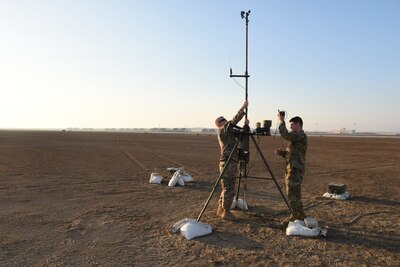
AL DHAFRA AIR BASE, United Arab Emirates, Dec. 10, 2018 —
The 380th Expeditionary Operational Support Squadron Weather Operations flight provides the 380th Air Expeditionary Wing with decision-quality environmental information to optimize decisive airpower across all five Air Force core missions.
“Weather is one of a few variables military leaders can’t control,” said Tech. Sgt. Kyle Lyons, 380th EOSS NCOIC of weather operations. “By exploiting the weather and providing timely and accurate information, weather personnel help mitigate risk, optimize lethality and provide a decisive advantage in all phases of operations.”
“While most people believe that military weather forecasters only focus on weather impacts at their specific location, that couldn’t be farther from the truth,” said Master Sgt. Kelly Hendricks, 380th EOSS superintendent and weather operations flight chief. “We are responsible for ensuring that all aircrews know what type of weather to expect throughout their entire route, so they can mission plan properly and ensure air tasking order completion.”
Since weather is constantly changing, weather personnel utilize a plethora of tools to provide timely, accurate and relevant information. Weather personnel rely on the science of meteorology and the art of communication to effectively inform decision makers.
“Predicting the weather starts with a process called ‘forecast funnel,’” said Lyons. “As the name implies, forecasters start at the top of the funnel to understand the big picture or global scale before understanding the small picture or local scale. Features such as the jet stream and low and high pressure systems give us the foundational blueprint to start from. We then take that information to construct how these large-scale features impact the region and specific locations.”
Each day starts with a comprehensive shift-change briefing. This ensures incoming personnel are cognizant of impending weather hazards across the area of responsibility, aware of upcoming missions, and advised of any equipment issues or special weather requests. Once the shift begins, forecasters are continually building their situational awareness to determine how weather threats may impact ADAB’s airframes, their missions, and the base.
“While working the operations desk, we need to be able to speak intelligently about weather effects at every location in the AOR where 380th AEW aircraft are operating,” added Lyons. “Additionally, we are tasked to support any transient aircraft that come through Al Dhafra. This means we must be prepared to provide a forecast outside the AOR, in support of any and all Department of Defense assets.”
Weather support in a deployed environment requires additional responsibilities for weather personnel. One such responsibility is to operate and maintain deployed weather equipment. At ADAB, weather operations maintains two AN/TMQ-53 Tactical Meteorological Observing Systems and a Portable Doppler Radar.
“The TMOS allows us to remotely monitor weather parameters, such as visibility, cloud height, wind speeds, temperature/humidity, pressure, lightning, among others, and on both ends of the runway,” said Lyons. “This information is critical to provide surface weather observations for an airfield or operating location enabling the airfield to be functional for military operations. The PDR allows us a continuous monitoring capability for weather threats to the base and generates over 20 meteorological products we use for resource protection and severe weather detection.”
On any given day, the ADAB weather flight provides weather information to every group and squadron on the installation, to include joint and coalition partners.
“While we are producing daily products and monitoring the weather, we also respond to a wide range of requests for information,” added Lyons. “These usually increase significantly if degraded weather is forecasted or occurring. Customers can vary from a pilot calling over the radio from the aircraft to get the current conditions, to the fitness center checking in to see if they can conduct physical fitness testing.”
Air Force Weather personnel are not only concerned with terrestrial weather, but also space weather, and the 380th EOSS weather flight provides one other unique capability that enhances the ADAB mission.
“With today’s heavy reliance on space-based assets, personnel must monitor space environment threats, such as a solar flare or coronal mass ejection that could affect or shut down military communications systems, satellites, and affect space vehicles and high-altitude flyers,” added Lyons. “Space weather events can have global or regional effects depending on the type and severity of the event.”
“Weather personnel are tasked with providing support to many different mission sets within the Army and the Air Force,” said Hendricks. “We cover not only aircraft, but also resource protection on every single base we have. Weather has the ability to impact all personnel, and it is our job to keep our aircrews and the base populace safe, especially during inclement weather.
“Every Air Force Specialty Code plays a role in supporting our operators and warfighters in completing the mission here,” added Hendricks. “Weather is here to ensure we’re all safe from meteorological hazards.”



